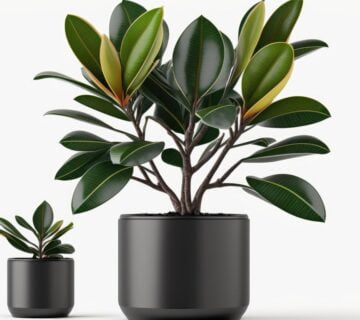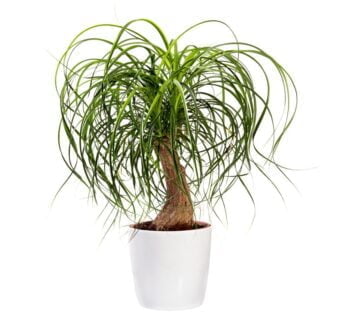ZZ Plant – Zamioculcas zamiifolia
ZZ Plant, scientifically known as Zamioculcas zamiifolia, is a popular and resilient houseplant with widespread recognition for its unique characteristics.
Hardy and Drought Tolerant:
The ZZ Plant is highly valued for its ability to thrive in low-light conditions and tolerate neglect. It is well-known for its exceptional drought tolerance, making it an ideal choice for busy individuals or those who forget to water their plants regularly.
Glossy, Dark Green Foliage:
The ZZ Plant showcases attractive, glossy, dark green leaves comprising several leaflets. The leaves emerge from thick, fleshy stems, giving the plant a distinctive appearance.
Air Purifying Properties:
Like many other indoor plants, the ZZ Plant improves indoor air quality by absorbing and filtering toxins from the surrounding environment, such as formaldehyde, benzene, and xylene.
Low Light Requirements:
The ZZ Plant can tolerate many lighting conditions, including low light. While it prefers bright, indirect light, it can adapt and thrive in areas with minimal natural light, such as offices or rooms with few windows.
Easy Propagation:
Propagating the ZZ Plant is relatively simple. It can be propagated through leaf cuttings or by dividing the plant’s rhizomes, which are underground stems. These propagation methods allow for expanding your ZZ Plant collection or sharing with fellow plant enthusiasts.
Slow Growth Rate:
The ZZ Plant has a slower growth rate than other houseplants. This characteristic makes it an excellent choice for those seeking a low-maintenance plant that does not require frequent pruning or repotting.
Adaptability to Various Climates:
The ZZ Plant can thrive in various climates, including tropical, subtropical, and even arid regions. It is native to parts of Eastern Africa, growing in shaded, rocky areas.
Potential Health Benefits:
Some studies suggest that indoor plants such as the ZZ Plant may contribute to improved mental health, increased productivity, and reduced stress levels. Additionally, caring for plants can provide a sense of well-being and relaxation.
Toxicity:
While the ZZ Plant is prized for its resilience and ease of care, it is important to note that it is toxic to pets and humans if ingested. Therefore, keeping it out of the reach of curious pets and children is essential.
Versatile Use:
The ZZ Plant’s attractive foliage and adaptability suit various settings. It can be displayed as a standalone specimen plant, incorporated into mixed indoor plant arrangements, or used as a striking focal point in the home or office decor.
Air Purifying Qualities:
The plant has air-purifying qualities for the indoor environment. A Study from the Department of Plant and Environmental Science at the University of Copenhagen 2014 shows that plants can remove volatile organic compounds from the air.
In summary, the ZZ Plant, or Zamioculcas zamiifolia, is a resilient and visually appealing houseplant that thrives in low-light conditions and requires minimal maintenance. Its glossy foliage, air-purifying properties, and adaptability to different climates have contributed to its popularity among plant enthusiasts. Whether you’re a novice or an experienced plant lover, the ZZ Plant is an excellent choice for adding greenery and natural beauty to any indoor space.
Things to know about ZZ PLANT
Common (vernacular) Name
ज़ीज़ी प्लांट (Hindi), ZZ plant, Zanzibar gem, eternity plant, Zamioculcas zamiifolia, Zuzu plant, aroid palm and many more.
Botanical Name
Zamioculcas zamiifolia
Origin
eastern Africa, from southern Kenya to northeastern South Africa.
Family
Araceae
Plant Type
Tropical plant
Plant Features
Ornamental / Evergreen / Exotic
Life Cycle
Perennial
USDA Hardiness Zones
9 to 11
Landscape Uses
Container Planting and Houseplants.
Species
Raven, Lucky Variegated, Zamicro, Zenzi, Dowon and Super Nova.
Varieties
It comes with few different varieties in a diversity of leaf.
Growth Shape / Habit
It comes with few different varieties in a diversity of leaf.
Size
Height : 2 to 4 feet tall and Width : 2 to 4 feet wide when mature.
Indoors or Outdoors
Outdoors : ZZ Plant can be grow outdoors in shady plantings, avoid direct sun light.
Indoors : Excellent plant grow in bright light or indirect light.
Blooming / Flowering
Although ZZ plant is a primarily foliage plant. The flowers are small and usually hidden under the base of the leaves.
Flower Colour
It’s come with cream/tan, green or white coloured spadix, similar to those of the peace lily.
Lucky Plant
According to Feng Shui and Vastu, It bring may good fortune, good lucky and brings harmony in a house.
Lighting / Sun Exposure
Bright Indirect Sunlight, it’s best to avoid direct sunlight.
Temperature
Grow best preferably warm temperature between 15°C to 24°C and does not fall below around 8°C.
Growth Rate
ZZ plant is a slow growers plant.
Watering
Moderate watering, Mist or over head sprinkler to provide water and to improve relative humidity. Not tolerate overwatering it may cause root damage and yellowing of the leaves.
Fertilizer
Slow-release fertilizer, or a water-soluble liquid fertilizer once or twice in the growing season (Spring through Summer).
i.e. - Cow dung, DAP, Compost, NPK 10-10-10 or 20-20-20 fertilizer, liquid organic fertilizer etc.
Pruning
Pruning of Anthurium not much is needed. However, trimming away only discolored or dead leaves.
Propagation
Seeds : The best time to sow your Anthurium seeds is in the end of Winter / early Spring but it can't can give good result.
Stem Cuttings : The easier methods of propagation of Anthurium in water or in soil via stem cuttings, and can be done during the warm growing season.
Division : Division of Anthurium can be done in Rainy season, or better in February to March.
Dormancy Period
Month : November to February (winter season)
Shed their leaves and show poor growth, Watering minimally.
Avoid : Propagate, Fertilize and Repotting.
Container
Ceramic Pot, Plastic Pot, Terracotta or Clay Pot is preferred, which ensures good drainage as well as water holding capacity.
Soil Type
A well-drained Loam / Coarse potting soil is recommended as well as water holding capacity. Prevent soggy potting medium.
Our recommendation for potting mix : Equal part mixture of Garden Soil (25%) + Compost (25%) + River Sand (25%) + Cocopeat (25%). You can substitute pieces of Charcoal, Vermicompost, Perlite etc.
Soil pH
Lightly Acidic soil - Ideally 5.5 to 6.5 pH (potential of hydrogen) is recommended for Anthurium.
Repotting
It is advisable to repot the Anthurium every year or two preferably spring to midsummer season.
Maintenance
Low maintenance and easy to grow.
Properties
Toxic or Poisonous to both humans and pets upon ingestion.
Benefits
Excellent indoor air purifier, Anthurium plants turns CO2 into oxygen. It purifies indoor air by removing harmful chemicals like ammonia, toluene, xylene and formaldehyde.
Special Features
Doesn't attract hummingbirds and pollinators like butterflies and bees or wasps.
Infestation / Pests
Aphids, Scale insects, Thrips, Mealy bugs, Spider mites and caterpillars etc.
Diseases / Problem
Physiological Problem : Anthracnose, Leaf Spot and Powdery Mildew.
Bacterial Problem : Bacterial Blight, Bacterial Wilt and Black Nose Disease.
Fungal Problems : Root Rot and Water Mold.
Some Glimpse of ZZ PLANT











No comment